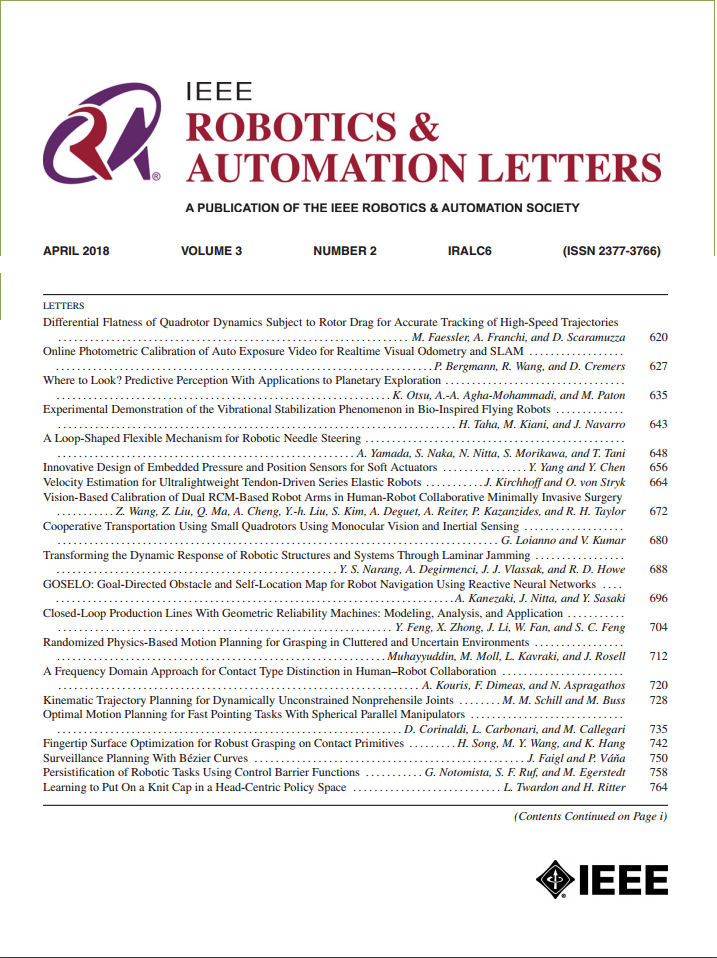Autonomous Decentralized Control for Motion Switching in an Intestine-Inspired Peristaltic Mixing Pump Adaptive to Physical Phase Transitions of Mixed Materials
IF 5.3
2区 计算机科学
Q2 ROBOTICS
引用次数: 0
Abstract
In this letter, we developed an autonomous decentralized control method that incorporates phase-difference adjustment based on a sigmoid function, enabling the design of both increases and decreases in discrepancy. The method was applied to a peristaltic mixing pump capable of mixing and transporting solid–liquid multiphase fluids. This study aims to realize a soft robotics system that autonomously switches motion modes according to changes in the physical properties of the transported material, thereby integratively mimicking both the motility and motion-switching functions of the intestine. Conventional autonomous decentralized control methods have been applied to the locomotion of amoeba-type and snake-type robots. However, when such control laws are applied to pumps, it is difficult to achieve appropriate motion switching in environments where the contents harden due to mixing. In this letter, we employed a sigmoid function that allows bidirectional control of discrepancy and constructed a new control law based on target phase-difference adjustment without feedback. The control law was implemented in a four-unit pump, and we confirmed that the desired motion patterns could be reproduced according to the preset target phase differences. As a result, the phase differences between all units converged to the target values within approximately 10–30 s after actuation began, producing the intended motion patterns. Furthermore, polyvinyl alcohol solution and borax water were used as contents whose fluidity decreases during mixing. We verified that autonomous motion switching occurred as the discrepancy increased. The results showed that, in units containing hardened material, a conveying motion with a phase difference of π/3 was generated, whereas in units with residual unmixed material, a mixing motion with a phase difference of π was generated. These findings demonstrate that the proposed method enables motion control that adapts to changes in material properties.适应混合物料物理相变的肠式蠕动混合泵运动切换的自主分散控制
在这封信中,我们开发了一种自治分散控制方法,该方法结合了基于sigmoid函数的相位差调整,可以同时设计差异的增加和减少。将该方法应用于混合输送固液多相流体的蠕动混合泵。本研究旨在实现一种软机器人系统,该系统可以根据输送材料的物理性质变化自主切换运动模式,从而综合模仿肠道的运动和运动切换功能。传统的自主分散控制方法已经应用于变形虫型和蛇形机器人的运动中。然而,当这种控制律应用于泵时,在内容物因混合而硬化的环境中很难实现适当的运动切换。在这封信中,我们采用了一个可以双向控制差值的sigmoid函数,构造了一个新的基于目标相位差调整的无反馈控制律。该控制律在四单元泵中实现,并证实了根据预设的目标相位差可以再现所需的运动模式。结果,在驱动开始后大约10-30秒内,所有单元之间的相位差收敛到目标值,产生预期的运动模式。以聚乙烯醇溶液和硼砂水为掺入物,混合过程中流动性降低。我们证实,随着差异的增加,自动运动切换发生了。结果表明,在含有硬化物料的单元中,产生相位差为π/3的输送运动,而在含有残余未混合物料的单元中,产生相位差为π的混合运动。这些发现表明,所提出的方法可以使运动控制适应材料性能的变化。
本文章由计算机程序翻译,如有差异,请以英文原文为准。
求助全文
约1分钟内获得全文
求助全文
来源期刊

IEEE Robotics and Automation Letters
Computer Science-Computer Science Applications
CiteScore
9.60
自引率
15.40%
发文量
1428
期刊介绍:
The scope of this journal is to publish peer-reviewed articles that provide a timely and concise account of innovative research ideas and application results, reporting significant theoretical findings and application case studies in areas of robotics and automation.
 求助内容:
求助内容: 应助结果提醒方式:
应助结果提醒方式:


